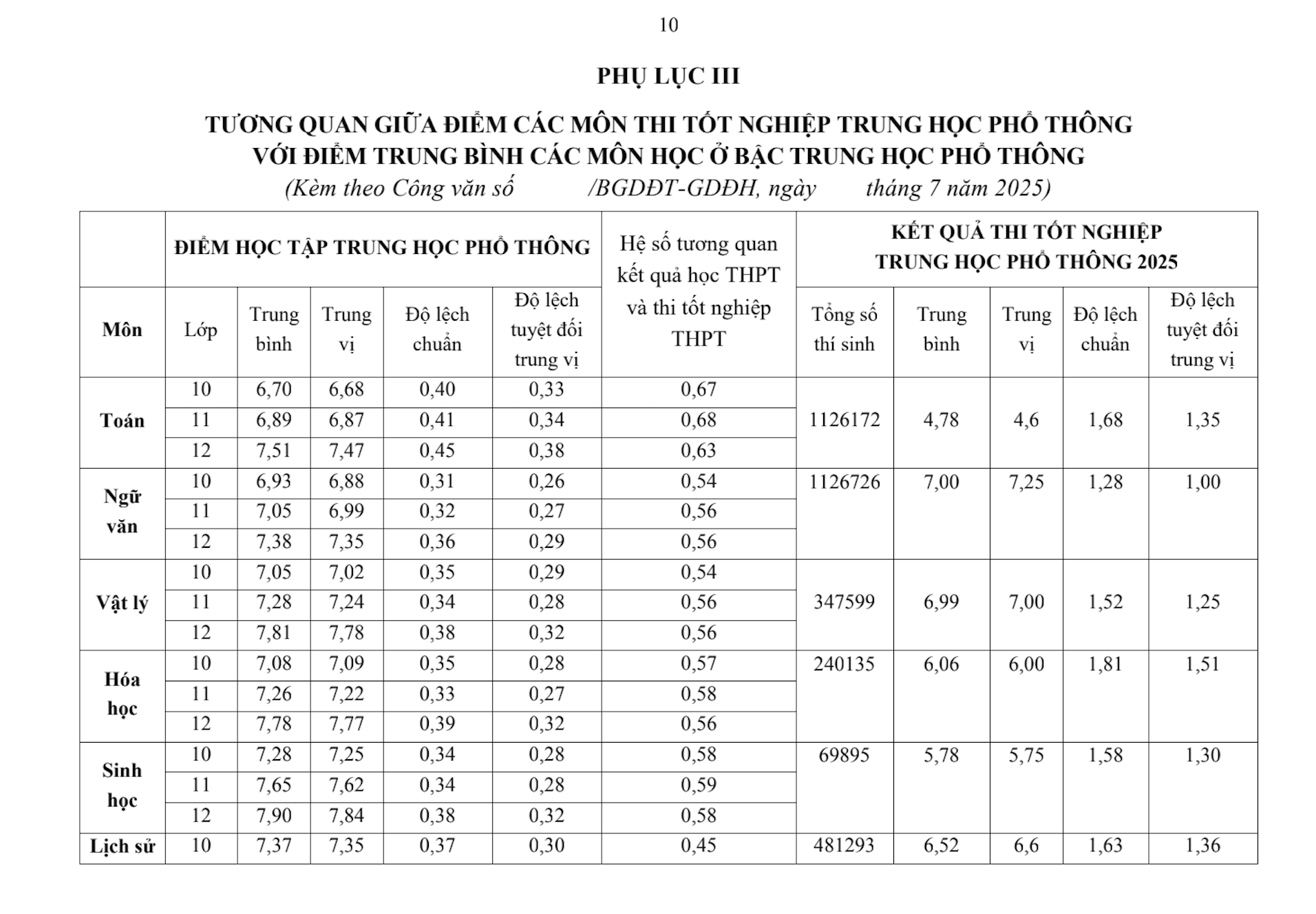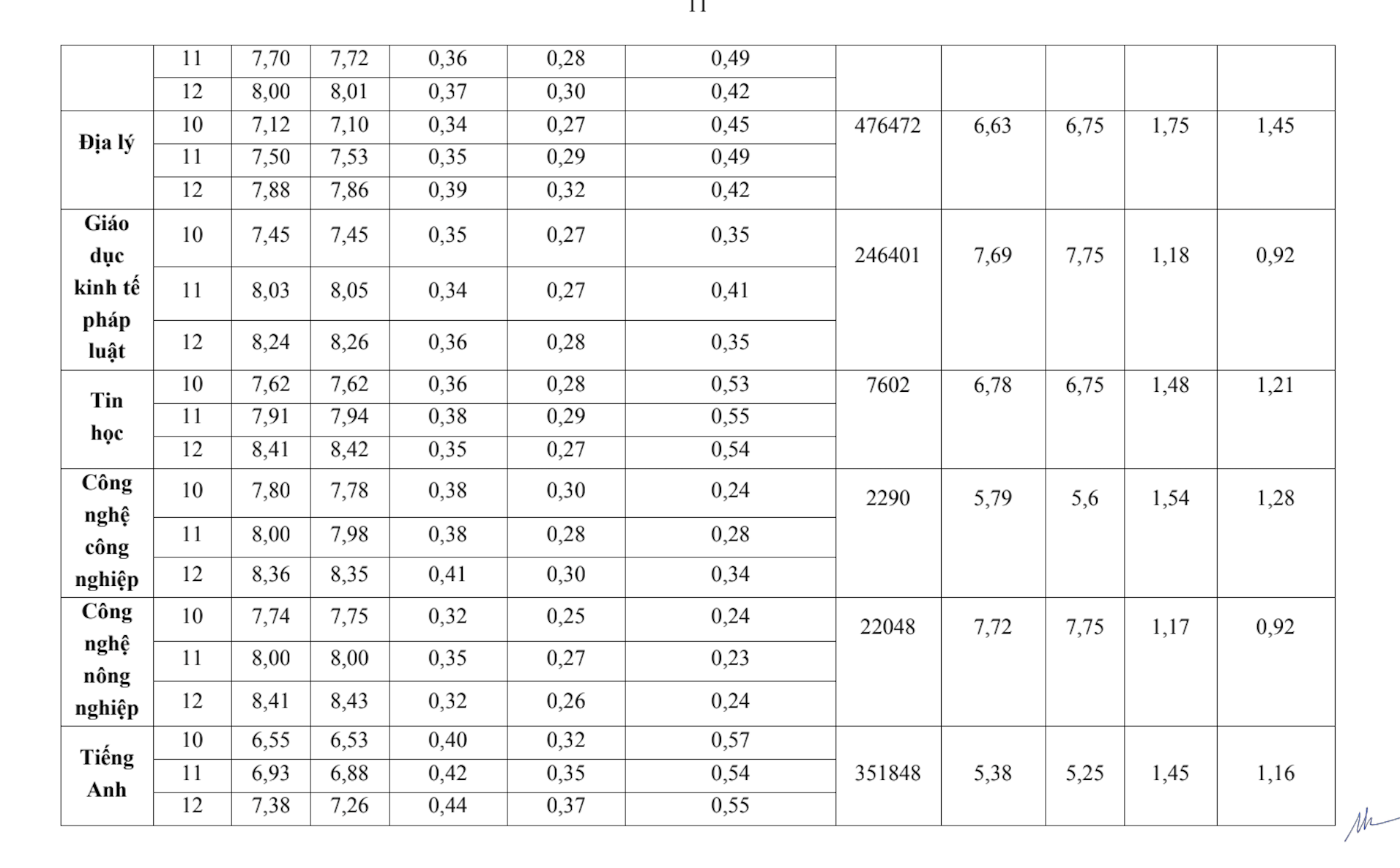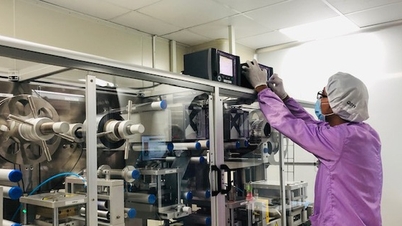12 subjects are different, Math is in the highest group
The Ministry of Education and Training has published a comparison table between the results of the high school graduation exam and the high school transcript scores (only counting the number of candidates taking the exam). In all 12 subjects, the average transcript scores are higher than the high school graduation exam scores, with the difference ranging from 0.12 to 2.26 points.
Of which, the Industrial Technology subject has the biggest difference in scores - 2.26 points - between the average high school transcript score of 8.05 and the average graduation exam score of 5.79 points.
Math ranked second in terms of difference, with an average report card score of 7.03, while the graduation exam score was only 4.78 - a difference of 2.25 points.
English difference is 1.57 points (6.95 vs 5.38); Biology difference is 1.83 points (7.61 vs 5.78).
Some other subjects also recorded significant differences such as Information Technology 1.2 points; Chemistry 1.31 points; History 1.17 points.
Literature alone has the lowest difference - only 0.12 points.


The gap between the transcript scores and the graduation exam scores is not new. In the 2006 program, there were years when the gap was up to 3 points. However, this year is the first time the graduation exam is organized according to the 2018 General Education Program, and a significant gap appears in some subjects such as Math, English, and Technology. In addition, the data also shows that the grade 12 transcript scores are often higher than those of grades 10 and 11.
Assessment of classroom learning and testing is not synchronized.
Mr. Tuan Anh, a Math teacher at Thu Duc High School (HCMC), said that the difference between the transcript scores and the graduation exam scores in subjects, especially Math, is due to many reasons.
Firstly, this year's graduation math exam is new, no longer has the chance of luck and no points are deducted for wrong answers in the true or false questions.
Second, this year's Math test is difficult because it has an application part. Students cannot learn by rote and apply formulas to solve problems, but must understand math and know how to solve practical math situations. Questions with many words also require patience and good reading comprehension.
Third, the assessment in school and from the test is not synchronized because this is the first year of testing according to the new program. For this reason, when teachers understand the assessment requirements from the official test and the source of documents is more abundant, the synchronization in assessment will be closer, then students will adapt better.
The fourth reason could be that the test was designed to classify students for university admission, not for graduation, so a high deviation is acceptable.
Regarding the reason why grade 12 report cards are often higher than grades 10 and 11, while in reality "the higher the grade, the harder it is", according to Mr. Tuan Anh, students entering grade 10 often have a mentality of relaxing (after the entrance exam to grade 10), not orienting their studies, going to grade 11 still leisurely, and only focusing on studying to get points and knowledge for the exam when they reach grade 12. However, he believes that there is another reason: teachers often evaluate grade 12 students and especially at the end of semester 2 more leniently to avoid pressure on them.

Another teacher said that the fact that the high school graduation exam scores in Math and English are much lower than the transcript scores shows that the exam has fulfilled its dual purpose: both for graduation and as a basis for university admission. In addition, the graduation exam is different from the classroom test because, in addition to assessing students' abilities after completing the general education program, it also has to meet the classification requirements for use by universities, so the difference is normal.
Why universities turn their backs on considering transcripts
Mr. Do Van Dung, former Principal of Ho Chi Minh City University of Technical Education, acknowledged that the difference between high school transcript scores and high school exam scores is not new. He said that the main reason for this difference is that teachers in high schools often "love" their students so they evaluate them lightly. Some schools even maintain two transcripts: One real transcript so that students know their true level and the other transcript with 2-3 points added to it to help them get into university more easily.
Mr. Dung said that this is the reason why the quality of admission based on transcripts has declined in recent years, leading many universities to turn their backs on this method by eliminating or reducing quotas. Moreover, the reality at universities shows that students admitted based on transcripts often cannot keep up with students admitted based on exam scores. This difference in level makes teaching difficult: if the questions are difficult enough for good students, they are not suitable for students based on transcripts. After 1-2 years, many students start to drop out, affecting the school's revenue. Therefore, for schools that value training quality, the admission method based on transcripts is no longer suitable.
"According to the data comparing high school exam scores and school records in 2025 announced by the Ministry of Education and Training, the average score of the 3-year high school report card is 7.12, while the exam score is 7.0 with an average deviation of only 0.12 points, but in some subjects such as Industrial Technology (deviation of 2.26 points) and Mathematics (deviation of 2.25 points), the difference is larger, partly confirming the situation of non-substantial assessment," said Mr. Dung.
The former principal of Ho Chi Minh City University of Technical Education said that in the context of the increasingly important role of the pedagogical industry, this problem of score difference is very serious because it can lead to poor quality admission, which will have long-term effects on future teachers and the general education system.
According to him, to overcome this, the Ministry of Education and Training needs to strengthen supervision and unify criteria for evaluating transcripts among high schools, and at the same time encourage universities to combine many admission methods such as competency assessment tests, interviews or considering transcripts with percentiles (applied this year) to ensure fairness and improve input quality.
Source: https://vietnamnet.vn/chenh-hon-2-diem-giua-hoc-ba-va-thi-tot-nghiep-giao-vien-nhe-tay-hay-de-thi-kho-2424698.html


![[Photo] General Secretary To Lam meets former British Prime Minister Tony Blair](https://vphoto.vietnam.vn/thumb/1200x675/vietnam/resource/IMAGE/2025/10/30/1761821573624_tbt-tl1-jpg.webp)

![[Photo] Touching scene of thousands of people saving the embankment from the raging water](https://vphoto.vietnam.vn/thumb/1200x675/vietnam/resource/IMAGE/2025/10/30/1761825173837_ndo_br_ho-de-3-jpg.webp)
![[Photo] General Secretary To Lam attends the Vietnam-UK High-Level Economic Conference](https://vphoto.vietnam.vn/thumb/1200x675/vietnam/resource/IMAGE/2025/10/30/1761825773922_anh-1-3371-jpg.webp)
![[Photo] The Third Patriotic Emulation Congress of the Central Internal Affairs Commission](https://vphoto.vietnam.vn/thumb/1200x675/vietnam/resource/IMAGE/2025/10/30/1761831176178_dh-thi-dua-yeu-nuoc-5076-2710-jpg.webp)












































































































Comment (0)